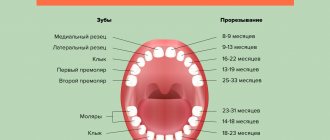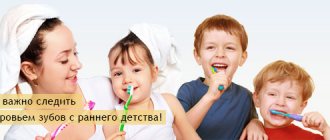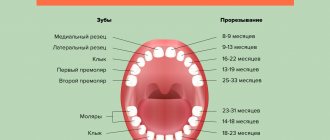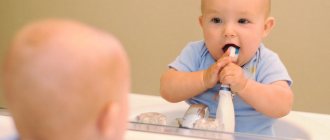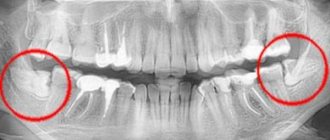You can help a child who is teething using both medicine and traditional methods. Babies experience severe discomfort and need the love and support of loving parents more than ever. The pain syndrome can be minor, so sometimes lightly massaging the gums and using teethers with cooling gel are enough to relieve symptoms. All methods are selected individually for each little patient. The eruption of teeth occurs in a certain order, so mom and dad are able to predict where inflammation and swelling are localized and direct all efforts to eliminate pain and itching.
Children's teeth
Every healthy baby eventually shows its first incisors. Their appearance obeys the laws of nature, the process is accompanied by certain symptoms, which in most cases are the same and go away in a few days. If you provide the baby with comfortable conditions and help cope with unpleasant sensations, the painful period will pass almost unnoticed.
Teething symptoms
Attentive parents can notice how the behavior of a little person changes when the first dental units appear. Panic arises from not knowing what to do when teeth are being cut, because the child often cries, and mom and dad forget about night rest and peace during the day. Other characteristic features:
- swelling of the mucous membranes and gums;
- excessive salivation;
- increase in body temperature to subfebrile levels and higher;
- a constant desire to put everything in the mouth and chew due to pain or itching;
- sleep problems;
- tearfulness, irritability or complete apathy;
- refusal of the mother's breast or bottle;
- stool disorders (diarrhea, constipation);
- redness of the throat due to increased blood flow;
- vomiting, excessive and frequent regurgitation;
- nasal congestion, cough;
- allergic rashes (in rare cases).
The listed symptoms are not always observed. Sometimes babies are not worried at all and behave as usual, so changes that have occurred can only be detected by examining the oral cavity. In the place of future dentition, white dots are visible - parts of crowns that have not fully erupted.
The emergence of fangs is often accompanied by pain in the eyes. The baby rubs them with his hands, blinks frequently, and may experience lacrimation.
In what order are teeth cut?
Before facilitating teething in a child with the help of drugs or non-drug methods, it is necessary to understand the sequence of appearance of all units and check for any deviations from generally accepted norms. The incisors come out first, then the premolars, canines and molars. However, each person’s body is individual, so small exceptions to the rules are possible.
Some babies show crowns very early, before six months of age. For other children this happens several months later.
Experts say that by the age of 3, a baby should have 20 crowns visible. Sometimes anomalies occur: incorrect placement and curvature of the rows, as well as darkening of the enamel. A brown surface may indicate that the expectant mother took antibacterial drugs during pregnancy. A yellow-green color often indicates problems with bilirubin metabolism. Also, in some cases, such a sign indicates liver disease and the death of red blood cells (erythrocytes).
Timing of teething in children
The upper and lower central incisors are fully erupted, usually at the age of 1 year. The process begins as early as 6 months. The lateral ones grow not much later. The canines emerge on the surface of the gums before the age of two; the growth of premolars and molars can extend over a longer period.
Parents should not panic if suddenly the baby’s first front teeth appear on one of the jaws, but on the other they are cutting only on the side. At the same time, it is important not to miss serious chronic pathologies, which are also accompanied by violation of generally established deadlines. If you have doubts that everything is in order, it is better to consult a doctor. Dental specialists will advise mom and dad, conduct diagnostic tests and, if necessary, refer you to specialist doctors.
The order of appearance of baby teeth
The appearance of teeth has a strict sequence, which indicates the correct formation of the masticatory apparatus:
- At the age of 9-10 months, the first lower and upper incisors appear.
- Up to a year (up to 12 months), the second upper and lower incisors erupt.
- The first upper and lower chewing teeth will appear at the age of 12-19 months.
- Fangs erupt between 16 and 22 months of age.
- The child will acquire second upper and lower chewing teeth between 20 and 30 months.
In general, the process of teething is the natural course of things. And it’s definitely not worth accelerating it with mechanical influences. But it is possible to help a child survive it with the least discomfort. The first symptoms of teething may appear a month or two before the actual appearance of the tooth! To prevent a child from feeling discomfort all the time, there are many everyday tricks and even medications designed to relieve pain and inflammation from children’s gums.
“Painkillers” for teething in children: types, methods of use
To facilitate the process of teething, you can use various painkillers, local and general. What types of means are there and are there any restrictions on their use?
To make the process of teething as easy as possible, dentists recommend massaging the child’s gums. The gums are massaged for 1-2 minutes with gentle circular movements with clean hands, while the fingers are wrapped in a sterile napkin. In this case, Asepta napkins, made in the form of a fingertip, have proven themselves to be excellent. Extracts of chamomile and witch hazel in the impregnation have a soothing and anti-inflammatory effect on inflamed gums, reducing pain and swelling.
In addition, it is important to constantly wipe your baby's drool if it drips onto the chin to avoid irritation or rash there. Teething is accompanied by copious salivation; during this period the child must be carefully monitored.
It is necessary to constantly maintain contact with the baby, take him in your arms often and try to distract him with some activities. It is recommended to talk a lot with the child in order to “drown out” his pain.
During teething, you can offer your baby special teethers - toys of various ring-shaped shapes rubberized or filled with cooling thermogel. Before giving such a thing to your child, experts recommend cooling it a little in the refrigerator. But not too much, since the child will refuse very cold toys, and if he does not refuse, he may catch a cold due to contact with a surface with a low temperature.
If the baby refuses special devices for teething and prefers to chew something chosen independently, there is no need to prevent this. However, it should be borne in mind that the object that the child puts into his mouth must be:
- is devoid of sharp protruding parts so that the baby does not cut himself;
- without small parts that a child can “gnaw off” and swallow/chokes on;
- consist of a substance that will not harm the child upon contact.
Many children love to chew on bread crusts or bagels while teething. This is a rather dangerous activity, since the child may choke on crumbs or damage the delicate oral cavity with them.
How to help without drugs
Medications are actively used during teething, but how to calm a child when teething using other methods? Massage prescribed by a dentist is highly effective. This way pain is eliminated by slight pressure. Another option is cooling the gums, which causes vasoconstriction (the principle is similar to the effect of ice on bruises and other injuries).
You need to massage painful areas exclusively with clean fingers. Silicone brushes are also suitable, suitable for babies six months of age and older. It is necessary to wash the accessory well and, if possible, sterilize it. Care should be taken to avoid excessive pressure. Some people are of the opinion that physical interference with the natural course of events can subsequently lead to caries and other pathological processes, but this is wrong.
Pharmacies and children's stores sell special teethers made of silicone and other soft materials that do not form jagged edges when chewed. The most effective are models with a non-uniform ribbed surface. Silicone rings with a gel-like substance inside are also used for cooling. You need to place the item in the freezer for a short time, and then give it to the baby.
Chilled complementary foods (mashed potatoes, juice, cottage cheese) will also relieve pain. A one-year-old can be offered a cool banana or apple.
TYPES OF GELS
Teething gel for infants is usually multi-component. Each of the ingredients performs a specific function in improving physical and psychological well-being. But a certain active ingredient occupies a leading position in the composition of the drug. It is its medicinal properties that underlie the classification of gels for gums during teething:
- painkillers, mainly with lidocaine. Reduce the severity of pain and resolve swelling for several hours;
- homeopathic. Contain microscopic doses of dilutions of beneficial substances of natural origin. Reduces inflammation, relieves pain, accelerates the restoration of damaged tissues;
- anti-inflammatory. Stops inflammatory processes, eliminates pain and swelling of the gums. They have some antiseptic effect, inhibiting the spread of pathogenic microorganisms.
The pharmacy assortment also includes combination ointments for teething. Their components have a variety of therapeutic properties. Such drugs are usually used for severe teething symptoms.
How to help your child with medicine when teething
For some children, homemade recipes and other non-drug methods do not help. This is due to the different sensitivity and susceptibility of the body of small patients. All medications should be selected exclusively by a doctor. It is likely that the infant has a history of chronic and other diseases for which drug therapy is strictly contraindicated. Self-prescription of pharmaceutical products can lead to allergic reactions and other side effects, so it is better not to rely on reviews on the Internet and advice from other mothers. Let's look at how to help a child teething with the help of medications.
Kalgel
The combined gel has an anesthetic and anti-inflammatory effect. The active ingredient is lidocaine, that is, inflamed and swollen gums seem to be “frozen.” Sold exclusively with a doctor's prescription. It is necessary to observe the exact dosage and avoid excessive use. The effect lasts for a long time.
Kamistad
Produced in Germany. The principle is almost identical to the previous drug, but the composition contains harmless polidocanol and tincture of chamomile flowers. Herbal components help eliminate pain, itching, inflammation, swelling and redness. The composition is sweet, so the little patient will not spit it out and will be happy to open his mouth. It is often prescribed by doctors for diseases of the oral cavity.
Holisal
The gel-like substance contains choline salicylate and auxiliary components. Prescribed also for adults. Allowed for use over six months of age. It acts quickly and relieves a wide range of dental problems. This is one of the best remedies for pain relief when a child is teething badly. The disadvantage is the higher cost compared to analogues.
Dentinox
A paste based on lidocaine and chamomile extract disinfects treated surfaces of the oral cavity, relieves pain and swelling of soft tissues. Unpleasant sensations are eliminated in a short period of time, the baby sleeps soundly, does not cry for no reason, and happily eats mother's milk or an adapted formula from a bottle. Since the gel is applied externally, it is completely safe when used in moderation.
The best organic and homeopathic remedies
When babies begin to erupt their first baby teeth, parents try to select homeopathic or organic remedies for them. These may be oral, topical or rectal medications. They are usually well tolerated.
Dantinorm Baby
Rating: 4.9
The French drug Dantinorm Baby is classified as homeopathic. This product contains 3 active ingredients: chamomile (eliminates irritability and inflammation), phytolactum (relieves pain during teething) and rhubarb (improves the digestion process). The composition does not contain ethanol, sugar and synthetic dyes. When teething, it can be used for small children.
Dantinorm Baby is a solution for internal use. The transparent liquid is contained in plastic nebulas, which are placed in groups of 5 in foil sealed bags. One nebula contains only 1 ml of solution. It is recommended to give 1 dose to the baby 2-3 times a day in between feedings for three days. The solution can only be poured in a sitting position to prevent the baby from choking.
When teething, parents prefer to give this homeopathic remedy in a course. And it fully justifies its purpose - children endure this period much easier. But some also give it once (at a time of acute pain). In this case, the drug also works, but less effectively. This product will be a godsend for those who are against lidocaine in the composition.
Advantages
- simple but effective composition;
- convenient packaging in nebulas;
- the solution is practically tasteless;
- provides good pain relief when used as a course.
Flaws
- if taken once, the pain relief is weaker.
Dentokind
Rating: 4.8
The German homeopathic remedy Dentokind contains: belladonna, chammomila, ferrum phosphoricum, hepar sulfuris and pulsatilla pratensis. A set of such components helps with painful symptoms that accompany the eruption of baby teeth in children. This drug is not suitable for patients with lactase deficiency, lactose intolerance, or glucose-galactose malabsorption.
Dentokind is available in the form of small lozenges. They have a flat cylindrical shape and a sweetish taste. They are placed in an amount of 150 pieces in a brown glass bottle. Dentokind is suitable for children from 0 to 6 years old. For children under two years of age, it is recommended to first dissolve the tablet in a teaspoon of water. When it comes into contact with liquid, it quickly begins to “melt”. The number of tablets allowed per day depends on the age of the child.
According to reviews, Dentokind primarily acts as a sedative. It perfectly eliminates the whims that usually intensify during teething. With this remedy, children sleep better, and it also reduces painful sensitivity, swelling and inflammation of the gums. Some people manage to “grow” even a single tooth with these tablets without the additional use of pain-relieving gels.
Advantages
- well thought out composition;
- tablets dissolve easily;
- pleasant taste;
- perfectly soothing;
- relieve pain, relieve inflammation.
Flaws
- Sometimes the condition gets worse when you start taking it.
Viburkol
Rating: 4.7
The German pharmaceutical company Heel produces the drug Viburcol. It contains 6 active homeopathic ingredients. This remedy is actively used to relieve clinical manifestations during the eruption of baby teeth. Viburkol has a pronounced antipyretic, anti-inflammatory, as well as mild analgesic and sedative effect.
This German product is produced in the form of rectal suppositories. They have a torpedo shape. Their color is white and there is no smell. Children under 6 months are recommended to use 1 suppository 2 times a day. From 6 months at a body temperature above 37.5 °C, 1 piece 4 times a day, and at a temperature above 38 °C, 1 piece up to 6 times a day.
Many parents willingly purchase Viburkol, despite its high cost, since it perfectly helps survive the teething period. These candles are quite convenient to use and they very quickly remove pronounced discomfort in the child during this period. This remedy is usually well tolerated, but in some babies it can cause mild diarrhea.
Advantages
- high-quality homeopathic remedy;
- suppositories are convenient to use;
- acts quickly;
- moderately relieves pain;
- soothes well;
- Excellent temperature reduction.
Flaws
- occasionally causes mild diarrhea.
Boiron Camilia
Rating: 4.6
The American analogue of the drug Dantinorm Baby contains the same homeopathic components: chamomile (soothes, reduces pain), phytolacca (eliminates pain), rhubarb (normalizes digestion for minor problems). This remedy is suitable for teething for children from 1 month and older. This product contains no benzocaine or preservatives.
Boiron Camilia is packaged exactly like Dantinorm Baby. The homeopathic solution for oral administration is contained in plastic nebulas. The maximum daily dose is 9 nebula. Their nose is broken off and the entire contents are sent into the baby’s mouth. If necessary, after 15 minutes you can give another dose and so on up to three times in a row. Children usually take this medicine without resistance.
Grateful parents speak very highly of this homeopathic remedy. They note that with such drops it is much easier to calm a capricious baby during teething. Boiron Camilia improves the quality of sleep of a suffering child and normalizes digestion. This remedy is usually well tolerated, but occasionally it can cause an allergic rash or loose stool.
Advantages
- good combination of components;
- absence of lidocaine and parabens in the composition;
- high-quality packaging;
- quickly calms down;
- has an analgesic effect.
Flaws
- can provoke an allergic rash and diarrhea.
Christopher's Original Formulas Kid-e-Col Extract
Rating: 4.6
The American brand Christopher's Original Formulas produces organic dietary supplement Kid-e-Col Extract. It perfectly relieves colic and pain that occurs during teething. The product contains organic catroot grass and organic fennel seed. Suitable for babies over 3 months.
Kid-e-Col extract comes in the form of drops that are placed in a dark glass bottle equipped with a dosing pipette. The solution has a pleasant taste and herbal aroma. It is recommended to shake the bottle well before use. For colic, you need to give 10-15 drops 3 times a day. You can give them every hour as needed. When teething, you can rub 3-4 drops of this product into the gums.
According to reviews, this remedy from Christopher's Original Formulas eliminates colic perfectly. But its analgesic effect is less pronounced, but for some children this supplement helps very well. In addition, this remedy calms the baby well and helps him sleep more soundly. However, parents note that such drops quite often provoke loose stools.
Advantages
- not overloaded organic composition;
- good dispenser;
- pleasant to use drops;
- perfectly relieves colic;
- provides good pain relief during teething;
- improves sleep quality.
Folk remedies
Medicines are effective for teething, but what should you give a child when teeth are cutting and you don’t want to use synthetic drugs? Home methods are auxiliary because they cannot always completely eliminate pain. However, for some children, these options are the most preferable and really help cope with pain. Doctors sometimes advise using:
- Compresses with chamomile. It is necessary to moisten a bandage or cotton pad in chamomile infusion and then apply it to the painful cheek. To relieve inflammation and swelling, dentists recommend giving several teaspoons of herbal tea.
- Honey. If the baby is not prone to allergic reactions, you can lubricate the inflamed mucous membranes with a honey substance. You should rub the substance in carefully, otherwise the baby will simply swallow it, and all manipulations will be useless.
- Soda solution. It is recommended to dissolve 1 tsp. soda in a glass of clean warm boiled water, dip a gauze cloth and wipe the gums. This product helps not only relieve pain, but also disinfect the surface.
Before using traditional methods, you must always consult a doctor, even if the herbal substances used are considered completely safe. Sign up for a consultation at the dental office, our specialists will recommend effective formulations that will not harm the little patient.
Folk remedies for teething in babies
For health problems in children, folk remedies help to quickly cope with diseases. When teething in infants, proven recipes are used:
- Herbal teas. Prepared from lavender, chamomile, lemon balm and primrose flowers. This tea is given to infants instead of water. The product helps reduce irritation and bring the baby’s nervous system back to normal.
- A decoction of burdock root, chickweed and chamomile. It is recommended to lubricate the baby’s gums with the product or make temporary applications.
- Clove oil. Helps relieve pain and relieve inflammation. It is recommended to mix with almond oil 1:1.
- Chamomile tea. Give them something to drink and moisten the problem area in infants with a gauze cloth.
- Valerian extract. Before use, dilute with water. A moistened sterile cloth is applied to the gums and left for 20–30 seconds.
- Shilajit solution. Has a pronounced analgesic effect. Teeth erupt quickly and without any unpleasant sensations for infants.
- Water tincture of propolis. The product is given orally or applied to the eruption site.
- Decoction of sage and plantain. Has an anesthetic and strengthening effect. The decoction is given to drink instead of water and used when bathing the baby.
Folk remedies for teething in babies are safe and effective. They not only relieve causative symptoms, but are also able to strengthen the immune system in infants.
How to calm your baby
Many young mothers worry about what to do and how to alleviate the condition when the child is teething, because he screams loudly and cannot sleep or eat normally. The best way to help a newborn is to breastfeed frequently. During the sucking process, the baby calms down, feeling maternal protection and love.
Parents may notice that regurgitation has become a common occurrence at this time. This feature is associated with abundant salivation and is quite natural. It is important not to confuse the periodic passage of air and food with vomiting, which is dangerous to life and health due to the high risk of dehydration.
Can a child’s baby teeth hurt: dental problems in children
Parents often ask: can baby teeth hurt in a 2-5 year old child? The answer from dentists in this case is always positive. Baby teeth are also susceptible to caries, just like permanent teeth. Moreover, superficial caries can quickly develop into deep caries - causing pulpitis and periodontitis.
Although caries is the main answer to the question “can baby teeth hurt in a 4-year-old child,” there are other dental diseases that provoke complaints in a child. Among them:
- enamel erosion;
- dental hypersensitivity;
- mechanical tooth trauma;
- stomatitis;
- gingivitis;
- periodontitis.
Gum diseases and mucosal ulcers are also included in this list, since a 3-5 year old child will say that his teeth hurt, and will not indicate the true problem.
Dental care
The oral cavity needs high-quality hygiene, even if only one incisor has erupted. At first, it is enough to wipe the crowns and gums with a cotton pad or a piece of bandage soaked in clean water (necessarily boiled). You can do this once a day for up to a year.
In one-year-old children, plaque formed from food is removed with a special silicone brush, which is placed on the finger of mom or dad. At 1.5 years old, the baby will be able to clean himself. Two-year-olds pick up the usual children's brushes with soft bristles, suitable for a certain age category.
One of the most important skills is the ability to rinse your mouth. At the age of two, a little person can already learn to do this on his own. Don’t forget about preventive visits to the pediatric dentist. The first visit is indicated at 12-14 months.
When to see a doctor
When discussing what to do when teething in children, how to treat inflamed gums, parents may not notice the onset of a pathological process that is not associated with natural signs. Symptoms that do not go away within several days most likely indicate a disease that requires urgent attention to a pediatrician.
In six-month-old babies, the immunity acquired in utero decreases, and their own is only at the initial stage of its formation. The baby is vulnerable to infections and viral agents. When teeth appear, lack of sleep and other discomfort are observed, as a result of which the protective functions of the child’s body are significantly reduced.
Alarm signals:
- a sustained increase in body temperature to 39 degrees or more, antipyretic drugs do not help or show little effectiveness;
- cough with a large amount of mucus;
- persistent stomach upset;
- blood in stool;
- ulcers on the mucous membranes of the mouth;
- prolonged runny nose, purulent nasal discharge;
- constipation for more than 3 days;
- the shade of the enamel differs from the norm, there are yellow spots or other inclusions;
- the crowns are positioned incorrectly and protrude significantly beyond the boundaries of the row.
If the baby is one year old and not a single tooth has appeared, it is necessary to undergo an examination. The problem probably arose due to a lack of minerals, metabolic disorders, and thyroid disease.
Prolonged diarrhea
In most cases, such symptoms are observed for no more than two days. However, exceptions are possible when the baby suffers from diarrhea for up to a week. In this case, it is recommended to visit a therapist. Your doctor will prescribe safe and effective medications to help harden your stool.
If you leave a dangerous sign unattended and think only about how to relieve pain from teething in a child, this can lead to severe dehydration and exhaustion. The most dangerous phenomena are bloody and mucous impurities in the stool.
Temperature
When the thermometer shows 38.5 or higher temperatures that do not subside, you should definitely call a pediatrician. The body of a small person does not yet have perfect thermoregulation; such a condition is extremely dangerous and sometimes life-threatening. Only a specialist should monitor a baby with a high fever.
Persistent cough
Minor sputum production and occasional coughing are considered normal. What to do when teething in children, how to treat it, if the cough syndrome does not go away and does not allow babies to breathe, eat and rest normally? Such symptoms, along with shortness of breath and hoarse breathing, should alert mom and dad. It is likely that, against the background of a decrease in the body’s defenses, a bacterial or viral infection has occurred.
Types of effective teething remedies
All medications are selected individually for the child. Today, teething painkillers for infants are available in the form of suppositories, tablets, solutions and ointments.
The best option is the use of gel-like pharmacological forms. This composition has good adhesion and remains on the oral mucosa for a long time.
When choosing a product, you need to pay attention to such details as:
- Composition of the drug. If there are allergic reactions in infants, you must carefully study the instructions on the composition. Even the best preparations with natural ingredients can cause irritation of soft tissues.
- Type of product. Today, homeopathic substances remain popular. They consist of natural ingredients. But they are more often taken orally. This promotes a cumulative effect and long-lasting effects.
- Pharmacy form. In most cases, the choice of a particular product depends on ease of use. It is better to apply gels or ointments locally for a quick effect. It is recommended for infants to take the drug orally at night.
Attention! Before using any medications, be sure to obtain advice from a doctor.
Let's sum it up
The appearance of the first incisors, canines and molars is the most important stage in the life of a small person. Parents should show special care and attention during this exciting period and support the baby as much as possible. You can help a teething child with both medications and non-drug methods. The main thing is to choose an effective and safe method, taking into account the individual characteristics of the child’s body. If suspicious symptoms occur, it is important to promptly consult a doctor to exclude infectious and other pathological processes not related to the emergence of new dental units.
Teething teething drops for infants: cheap analogues
The above drugs have analogues that are cheaper, but have the same effect. Doctors advise for children under one year old to try:
- Phytodent;
- Dentinox, Denta;
- Stomagol.
The approximate price of these medicines ranges from 100 to 150 rubles.
Attention! Many dental drops may contain valerian extract, which is unsafe for children, so before purchasing the drug, carefully study its composition; this is allowed in licensed pharmacies.
